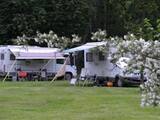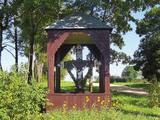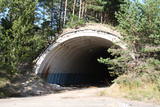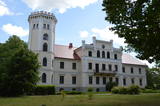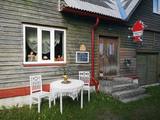| Нo | Название | Описание |
|---|---|---|
|
Familienbetrieb Hiiu Vill ist einer der wenigsten Wollebearbeitung-Unternehmen in Estland, wo zum Bearbeiten der Schafwolle die polnische Maschienen (Krempelwolf, Spinnmaschiene etc.) aus der 19. Jh. benutzt wird. Gäste sind hier herzlich willkommen. Im Sommer gibt es draussen ein Cafe und ganzjährig besteht die Möglichkeit Wollesachen einzukaufen. |
||
|
Это один из 6 маршрутов путешествий в серии «Насладитесь деревней!», который приглашает Примерное время прохождения маршрута: четыре – пять дней, в зависимости от количества выбранных достопримечательностей и времени, отведенного для их осмотра. |
||
|
Apmeklētājiem tiek piedāvāta ekskursija ar stāstiem par Limbažiem, kas kādā veidā saistīti ar sudrabu. Ekskursijas laikā iespējams apskatīt paraugdemonstrējumus lodēšanā. Sadarbībā ar juvelieriem, darbnīcā būs iespējas apgūt prasmes darbam ar misiņu un sudrabu, tiks piedāvātas arī meistarklases. Pēc iepriekšējas pieteikšanās grupām būs pieejamas arī O.Auzera lekcijas par sudraba ietekmi uz veselību. Ekspozīcija atvērta apmeklētājiem no trešdienas līdz svētdienai no pl.10:00-17:00, citā laikā grupām- pēc iepriekšēja pieteikuma. Ieejas maksa: |
||
|
The "Jurmala" campsite is located in the park territory of the "Rīgas Līcis" sanatorium and offers facilitated tent, camper and caravan sites, as well as holiday homes for rent. The campsite is located next to the beach and is suitable for recreation with family and friends, as well as for organizing a variety of thematic and recreational events. The proximity to the "Dubulti" and "Jaundubulti" railway stations makes it easy to move around Jurmala or get to Riga. The campsite is also suitable for families with pets. |
||
|
Tūrisma gide Ineta Jansone piedāvā ekskursijas grupām pa Raganu purvu. Izveidota taka uz sēra dīķiem (koka celiņi 800 m garumā). Ekskursijas laikā Jūs uzzināsiet par augstā tipa purvu un unikālu biotopu – sēra avotu izplūdes vietu Ķemeru Nacionālā parka teritorijā. Šeit sastopami savdabīgi purva ezeriņi, piesātināti ar sēra baktēriju radītām nogulsnēm. Ezeriņu krastos sastopami īpašu sugu augi. Sēra dīķu apkaimē var sajust gaisā sērūdeņraža smaržu. |
||
|
Распятие Ружини является одним из характерных для
Латгалии. При строительстве использовано дерево, как это
традиционно делалось в прежние времена.
|
||
|
Viens no lielākajiem Augštaitijas pilskalniem, kas 2011. g. pēc vērienīgiem rekonstrukcijas darbiem ir izzināms jaunā kvalitātē - gan no infrastruktūras, gan arī ainaviskā viedokļa, jo iepriekš biezais pamežs (tagad retināts) traucēja uztvert iespaidīgo objektu. Arī no pilskalna plakuma paveras labs skats uz diviem blakus esošajiem ezeriem. Tā virsotnē apskatāms piemiņas akmens, kas vēsta par pirmā Lietuvas valsts prezidenta Antana Smetona (Antanas Smetona) apmeklējumu 1934. g. viņa 60 gadu jubilejā. Pilskalns it ticis apdzīvots jau I tūkstošgadē pirms Kristus. Uzskata, ka 14. – 15. gs. te atradusies hronikās aprakstītā Linkmenu pils. Jaunizveidotā taka pilskalnu savieno ar vēl vienu populāru apskates objektu – Ladakalni. |
||
|
Организация мастер-классов по приготовлению национальных блюд удмуртской и остальной финно-угорской кухни, знакомство с культурой других народов через кулинарные традиции. |
||
|
Когда-то зенитноракетная бригада в Цирпстене была значимым военным объектом береговой охраны. Визуально интересная и впечатляющая территория вблизи морского побережья, к сожалению, по причине недостаточного ухода загрязнена и необустроена.
|
||
|
Один из популярнейших туристическихобъектов Латгалии.С вершины возвышенности (247 м н.у.м., около 60 м над ближайшими окрестностями) приоткрывается один из красивейших видов Латгалии на находящееся в двух километрах озеро Разна. На Маконькалнсе находится построенный в XIII веке и практически неприступный замок Ливонского ордена Фолкенберг – одно из первых укреплений Латгалии, от которого до наших дней сохранились только фрагменты стен . У подножья Маконькалнса открыта памятная доска, вещающая о посещении Латгалии президентом Первой Латвийской Республики Карлисом Улманисом в 1938 году. |
||
|
Skaistā ēka atrodas Lizuma centrā. Lizuma muižas īpašumi piederējuši dažādām dzimtām – vācbaltiešiem Tīzenhauzeniem, Malamiem un Volfiem. 1836. g. muižu iegādājas barons Otto Gotlībs fon Volfs, kura laikā muižas pils iegūst tagadējo veidolu – Tjudoru neogotikas stilu ar poligonālu torni. Jau no 1937. g. pilī izvietojusies Lizuma skola, kas ir viens no iemesliem, kādēļ saglabājusies ne tikai pati ēka, bet arī atsevišķi interjera elementi kāpņu telpā, Zilajā (Mednieku) zālē u.c. Pili ieskauj parks, kur atrodas muižas saimniecības ēkas – mūra klēts (te kultūras nams), 1876. g. celtais zirgu stallis (sporta halle), kalpu un dārznieka namiņš u.c. Bijušajā spirta brūzī ražo Gotiņas konfektes. Pils tornī izveidots Lizuma vidusskolas veidotais novadpētniecības muzejs. |
||
|
Meklējams 0,3 km no Līvānu dzelzceļa stacijas – Fabrikas un Stacijas ielu krustojuma tuvumā. Ideja par Līvānu atbrīvošanas pieminekli radās jau 1929. g., taču to īstenoja 1935. gadā (arhitekts Pāvils Dreimanis). Tā galvenais elements bija 15 tonnas smags Krievijas armijas pamests lielgabala stobrs. 1958. gadā pieminekli iznīcināja, jo tas nebija „tīkams” padomju varai. No jauna to atklāja 2004. gadā. Piemineklis veltīts brīvības cīņās kritušo latviešu kareivju piemiņai, kuri 1919. g. ieņēma un atbrīvoja pilsētu no lieliniekiem. |
||
|
Of the many islands in Lake Rušons, ten are restricted natural areas so as to protect the broadleaf forests which are on the islands and the endangered plants found therein. An ancient cult location – the Rušons Sacrificial Rock – is found on Upursala island.
|
||
|
Druskininkai tradicionāli ir bijusi kūrortpilsēta - tā piedāvā mežu, Nemunas krastu un ezeru ieskautu mūsdienīgu SPA viesnīcu kompleksu un ūdens atrakciju parku, kā arī plašu gājēju un veloceliņu tīklu. Turpat netālu atrodas iekštelpu slēpošanas kalns "Snoras Snow Arena", kurš ir pirmais un vienīgais ziemas izklaides centrs Baltijas valstīs un darbojas visu gadu.
|
||
|
В помещении бывшей столовой Kantküla открыт пункт общественного питания, где предлагаются блюда, приготовленные из свежих местных продуктов. Обед подается в виде буфета, в летний период также предлагается a la carte или меню со свободным выбором блюд. Также предлагаются места для ночлега и услуги питания. |
||
|
Начиная с 2007 года, каждый интересующийся может осмотреть производство фарфора, экспозицию с фарфоровыми изделиями, приобрести сувениры или сделать индивидуальный заказ. Для детей особую радость доставляют занятия в студии по росписи фарфора, которая находится здесь же недалеко, в бывшем дворце господской усадьбы «Вецпиебалгас». |
||
|
Паулс Сукатниекс (1914 - 1989) - первый селекционер винограда жил и работал в «Апситес». В настоящее время жилой дом восстановлен, в нем представлены предметы быта и другие предметы, используемые на сельском дворе, а также библиотека и мастерская П. Сукатниека. Вокруг «Апситес» разбит ухоженный сад, где можно увидеть как местные, так и привезенные сорта декоративных растений, кустарников и деревьев, в т.ч. и редко встречающиеся. Можно осмотреть и ознакомиться с селекционированными П. Сукатниеком сортами винограда и виноградником. Рядом с домом расположен информационный стенд о наблюдении за птицами в пойме Двиете. Желающие могут ознакомиться с садом и с «Апситес» в сопровождении гида. В саду оборудовано место для отдыха и пикника, проводятся толоки (субботники) и образовательные мероприятия |
||
|
The Samovar House is a small samovar museum located in the Old Believers’ village near Lake Peipus, which has a private collection with more than 100 different and very special samovars and objects related to samovars.
|
||
|
Найссаар- маленький эстонский остров, которым с конца II Мировой войны до 1993-го года владели советские вооруженные силы. Достопримечательностями острова являются прогулочные тропы, богатая видами природа, узкоколейная железная дорога, артиллерийская батарея царских времен и завод морских мин советского времени. |
||
|
Atrodas Kalēju ielas malā. Savu popularitāti ieguvis ar nostāstu, ka Ziemeļu kara laikā pie tā pusdienojis Krievijas cars Pēteris I un Polijas valdnieks Augusts (Stiprais). |
||





